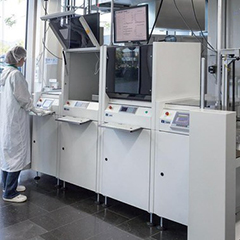When the Fraunhofer ISE Photovoltaic Technology Evaluation Center PV-TEC was inaugurated in Spring 2006, it was the first research-based pilot line for crystalline silicon solar cells. Back then with support from the German Federal Ministry for the Environment, Fraunhofer ISE PV-TEC was able to build a new, unique service center for the photovoltaic (PV) industry. With laboratory facilities stretching over 1200 m², PV-TEC continues to offer research, development and services on an industrial production level. Through its pioneering work in the field, the technology transfer to PV industry began to grow at an accelerated rate. Germany soon became a leading nation in the area of solar cell production and production technology, the latter still holding today. PV-TEC’s ten year jubilee was celebrated in Freiburg on April 13, 2016 in the presence of high-level representatives of the Baden-Wuerttemberg Ministry for the Environment as well as the German Federal Ministry for Economic Affairs and Energy as well as more than 50 leading representatives of PV industry. The location of the event – and also a reason for celebration – is the new laboratory addition “PV-TEC Select.” With its new infrastructure in place, the lab’s aim is to realize solar cell efficiencies of 25 percent. PV-TEC Select will be officially inaugurated at the jubilee.
Back in 2006, the goal of PV-TEC was not only to reduce the cost of solar electricity but also to establish quality assurance for efficient R&D in photovoltaics, thus supporting and strengthening the German and European PV industry. Additionally education and training are important at PV-TEC. At its start, PV-TEC was equipped to process the classic screen printed solar cell. Later with support from the federal and state governments, the system technology could be augmented to manufacture more up-to-date solar cell structures with passivated surfaces. In all, the laboratory has contributed significantly to the introduction of new technologies in industrial production over the past ten years.


























